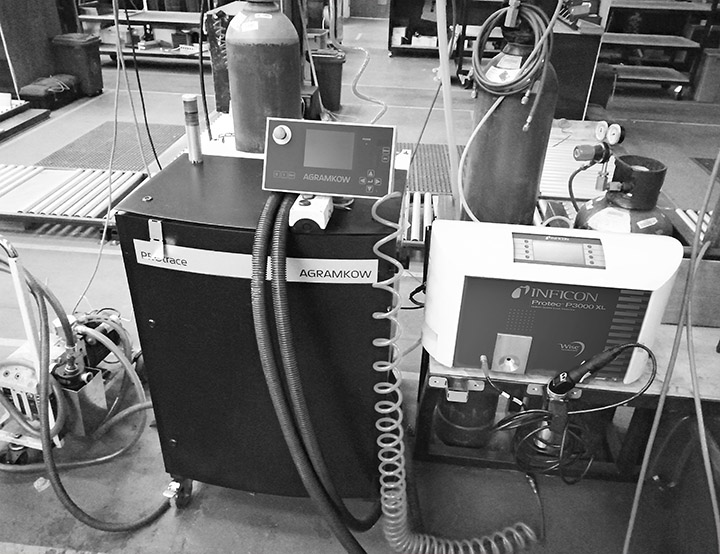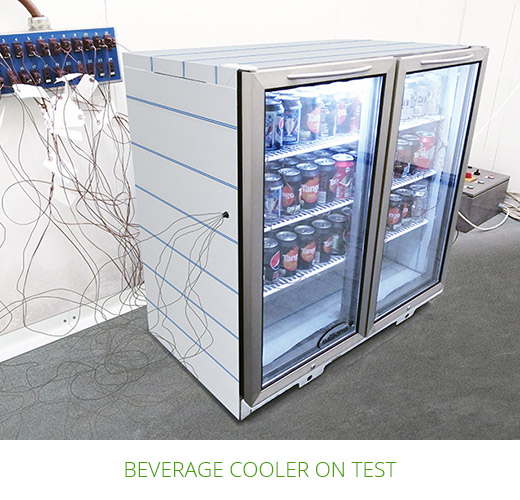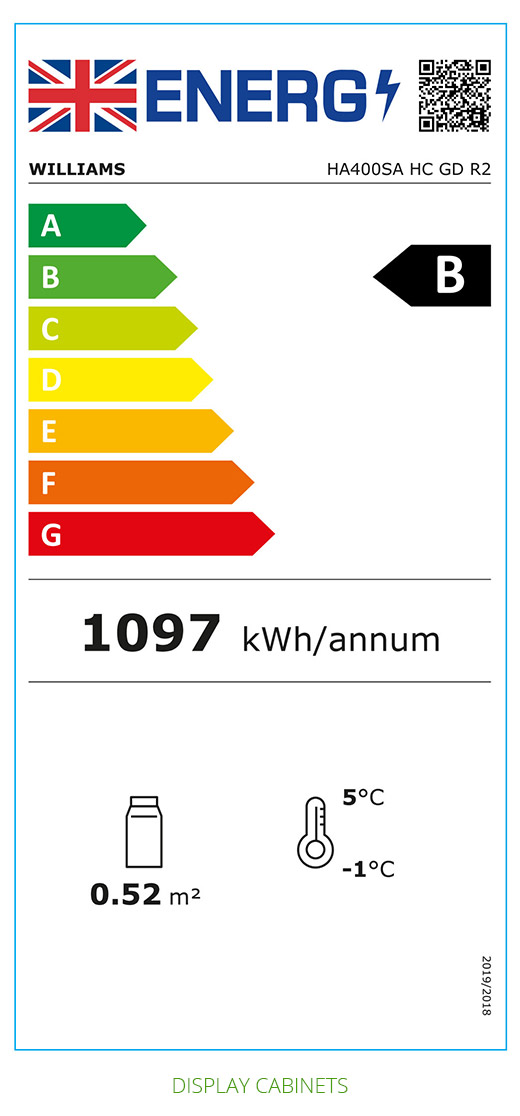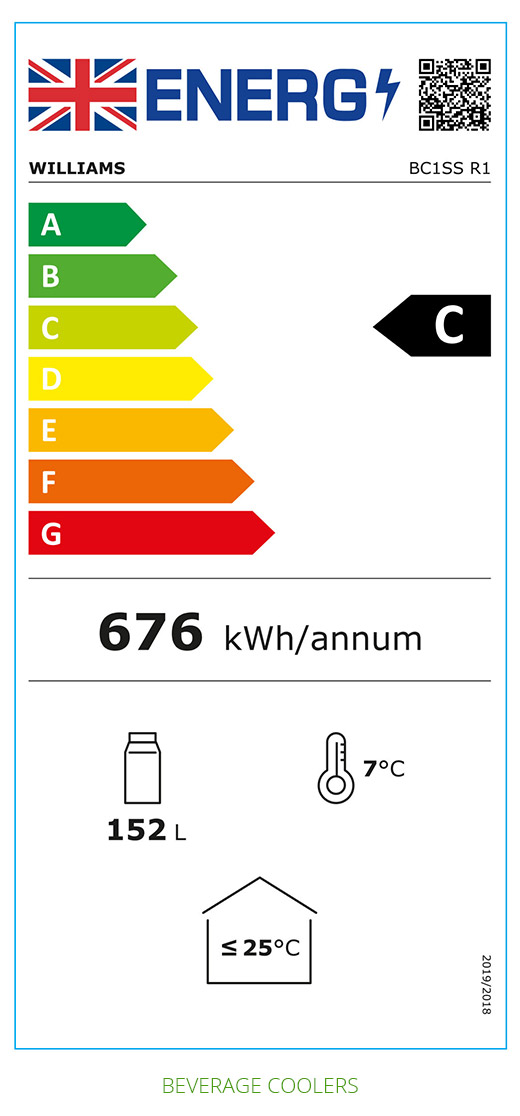

Williams’ commitment to green refrigeration stretches back decades. In the 1980s we were the first manufacturer to develop CFC-free insulation. In the 1990s we developed the first catering refrigeration to use environment- friendly refrigerant with an Ozone Depletion Potential (ODP) of zero. We’ve continually pioneered a raft of greener technologies, ranging from energy-saving ‘Smart Controllers’ to systems using eco-friendly refrigerants including natural hydrocarbon.
Our products are 99% recyclable, reducing the impact on future landfill. The remaining 1% consists of condensate from compressors, which is treated by a third-party partner. Even our used oils go through a purification process that sees them refined and filtered, with the oil residues burnt in furnaces to make energy.
Foam is shredded and bailed, which is also used to produce energy.
We believe it is paramount to ensure our products are as sustainable as possible and apply active and continual consideration for each and every component. We are not just looking at the contribution they make to the product’s overall energy efficiency, but also the impact they have on the environment, ensuring they have been manufactured using a sustainable and ethical process.
Williams continue to pioneer and promote the use of alternative, environment friendly natural refrigerants as standard across its ranges.
Williams first developed the use of natural hydrocarbon refrigerant back in 2007 and began exclusively introducing greener refrigerants for much of its ranges, including reach-in models and modular products, in 2013.
Now, we use natural refrigerants as standard for all our food storage cabinets.
Our CoolSmart Controller minimises a cabinet’s energy consumption through processes such as fan and heater pulsing, intelligent defrost and independent management of evaporator and condenser fans.
Our insulation delivers structural strength and superior thermal properties while minimising environmental impact through low GWP (Global Warming Potential) and zero ODP (Ozone Depletion Potential).
Our low energy fans resist corrosion to maximise service life. Our coils are electro deposition dipped – an advanced high quality cathodic coating technology. This has a lower environmental impact due to a reduction in the amount of solvents used.
Our products also include a comprehensive choice of additional energy saving features and options such as self-closing doors, heavy duty gaskets, half doors and drawer packs.
F-Gases are man-made refrigerants which have often been used instead of ozone depleting substances such as chlorofluorocarbons (CFCs) & hydro- chlorofluorocarbons (HFCs). However, F-Gases are powerful greenhouse gases, with a global warming effect of up to 23,000 times greater than Carbon Dioxide.
There has been an important change to F-Gas Regulations in recent years to reduce emissions of greenhouse fluorinated gases (F-Gases) used in refrigeration (and air conditioning).
The original F-Gas regulation in 2006 focussed on controlling emissions through improved installations, F-Gas recovery and engineering training.
The updated regulation in 2014 aimed to achieve a 79% cut in emissions across the EU from 2015 to 2030.
From 2015 revised F-Gas regulations saw further measures taken to contain the gas e.g. leak checks and regular record keeping.
To further help achieve the 79% target, legislation now includes the ban on some F-Gases and encourages the use of technologies operating on refrigerants with a significantly lower Global Warming Potential (GWP).
Owners of equipment containing F-Gas must adhere to a number of legal responsibilities and breaching them can potentially lead to fines, penalties or criminal offence charges. In the UK, infringements can result in fines from £1,000 to £200,000.
If your business carries out the installation or servicing of refrigeration or air- conditioning containing F-Gas refrigerants then by law, an F-Gas company certificate must be obtained and renewed every three years.
Further information available here
Natural hydrocarbon refrigerant reduces energy consumption by up to 15% due to its excellent thermodynamic properties and it almost eliminates any environmental impact due to its low GWP and zero ODP.
Our low energy compressors, specifically designed for use in hydrocarbon units, are all VDE approved, and all current products fall below the 150g threshold for hydrocarbon equipment.
We have taken measures to ensure our manufacturing process is fast, efficient and safe and have recently invested in a fourth automatic charging and evacuation station for hydrocarbon refrigerants.
COSTS – Even though service technicians can still provide refrigerant maintenance to equipment operating on R404A or R134a, the costs are likely to drastically rise due to reduced availability in these gases.
Latest industry findings suggest that the ban from January 2020 on refrigerants with a GWP of 2,500 or more has seen a significant increase in reclaimed gas prices, with these as high as twice the price of virgin gases.
This data has been produced on behalf of the European Commission by German consultancy Öko-Recherche.
Therefore, investing in newer equipment using a natural refrigerant will not only increase best environmental practice but can also potentially decrease maintenance costs.
NEXT STEPS – Acting on the phase out sooner rather than later can save time and money, as well as boost eco-initiatives.
Things to consider when initiating your own phase out plan include replacing equipment over 5 years old which are out of warranty, identify refrigerant gas used in new models and finding out more information on efficiency and performance via the distributor or manufacturer.
Williams Refrigeration can help in these areas as well as being able to provide a flexible payment solution to spread the cost of quality, market leading refrigeration equipment.
From 2020
All refrigeration equipment running on HFCs with a GWP of 2,500 or more have been banned since 1st January 2020. This includes R404A refrigerant.
From 2022
All F-Gases with a GWP of more than 150 will be banned in the sale of reach-in models. This includes R134a refrigerant.
From 2030
Reclaimed and/or recovered refrigerants with a GWP of more than 2,500 for service and maintenance for refrigeration and freezer equipment will be banned. This includes R404A refrigerant.
After Sales / Service
Regulation guidelines state that an F-Gas with a GWP of more 2,500 can be used only if it has been reclaimed or recovered from similar equipment and up until 2030.
‘Retrofilling’ is encouraged. F-Gas is removed from the system and replaced with an alternative with the lowest possible GWP, or to fully replace the refrigeration system with new equipment that uses a refrigerant with a lower GWP.
Williams first developed the use of R290 hydrocarbon refrigerant in 2007 and began introducing it to many of our ranges in the subsequent years, while also incorporating other natural refrigerants R600a and R452A in reach-in models and modular and blast cabinets respectively.
Williams is actively monitoring current regulation where models require more than 150g of hydrocarbon refrigerant as well as continuing to introduce natural refrigerants as standard across our ranges, where feasible to do so.

Williams has adopted a zero tolerance refrigerant leak strategy. All coils are pre-tested and tested again when the refrigeration system has been assembled using industry-best helium sensors - capable of detection to just 0.5g per annum.
Systems are purged during brazing with Oxygen Free Nitrogen (OFN) to reduce carbon build up, extending both component and product life.
Williams has invested across all manufacturing plants in the latest leak detection technology that brings new levels of reliability to leak testing. Each and every cabinet is leak checked prior to being charged with refrigerant.
The leak detectors are highly sensitive and specifically designed for our demanding production environment and have a minimum detectable leak rate of 0.05 grams/annum.



The Minimum Energy Performance Standard came into effect in July 2016 for professional refrigerated storage cabinets and counters (BS EN 16825/EN ISO 22041).
It is set by The European Commission to limit the maximum amount of energy that may be consumed by a product, while in operation. The temperature and energy performance are tested and ranked against the Test Standards and is displayed in the form of an energy label.
From July 2019, the energy label for professional cabinets and counters has displayed energy efficiency classes ranked A+++ to G (formerly A to G).
There is currently no label required for Blast Cabinets but in 2016 it became mandatory to declare energy data within the Operating Manual. Tests are conducted to BS EN 17032.
Energy labels for products bound for the UK market will have a Union Jack printed on the label, while products bound for the European market will have the flag of Europe.
From January 2019, suppliers have been required to register all equipment requiring an energy label with the EUROPEAN PRODUCT DATABASE for ENERGY LABELLING (EPREL) .This database went live to the public via the EPREL website in March 2021. View the database here.
Since March 2021, Display Cabinets (BS EN ISO 23953) and Beverage Coolers (BS EN 16902) also have a minimum energy threshold and label applied.
Energy labels for Display Cabinets and Beverage Coolers include a QR Code, taking the end user directly to the manufacturer’s website if within the UK or the EPREL website if sold within the EU.
The tests prescribed within the above Test Standards are conducted within Williams’ four independently calibrated environmental test chambers.
• Coldrooms
Waiting for enforcement date to be announced
• Refrigerated storage cabinets and counters for Professional use
currently not encompassed by the scope of the standard. For example preparation counters fitted with a gastronorm well
ETL (Energy Technology List)
The ETL (Energy Technology List) is a government-managed list of energy-efficient plant and machinery. It is part of the ECA (Enhanced Capital Allowance) tax scheme for businesses. However, from April 2020 the scheme ceased to offer any tax relief of buying products from the ETL.
Despite this amendment to its process, the ETL still acts as an important tool, with buyers safe in the knowledge that every product listed complies with ETL scheme standards and are energy-efficient.
Williams has a number of products on the ETL.
Click here to see the full list.



